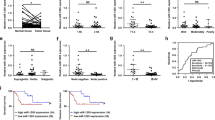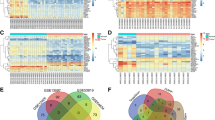Abstract
Background
MiR-4497 has been previously proved to exert an anti-cancer role in laryngeal squamous cell carcinoma (LSCC) by negatively regulating gastrulation brain homeobox 2 (GBX2). However, the mechanism of miR-4497 in LSCC has yet to be fully elucidated. This study intended to investigate the role of FEZF1-AS1 in the migration and invasion of LSCC cells and clarified its mechanism through miR-4497 and GBX2.
Methods
qPCR evaluated the expression of FEZF1-AS1, miR-4497 and GBX2 in LSCC tissues and cells, compared with controls. Western blotting analyzed GBX2, E-cadherin, N-cadherin and Vimentin. CCK8, wound healing and transwell assays assessed the viability, migration and invasion of TU686 and UM-SCC-17A cells. Luciferase reporter assay affirmed the interplay of miR-4497 with FEZF1-AS1 or GBX2 and Pearson’s correlation analysis explored the association between each two genes in both tumor and non-tumor tissues.
Results
FEZF1-AS1 was highly expressed in LSCC tissues and cells. Silence or elevation of FEZF1-AS1 inhibited or promoted the migration and invasion of TU686 and UM-SCC-17A cells. FEZF1-AS1 targeted and negatively modulated miR-4497. Inhibition of miR-4497 markedly restored the FEZF1-AS1 silence-repressed cell viability of TU686 and UM-SCC-17A cells. Further, FEZF1-AS1 could positively regulate GBX2 via negative regulation of miR-4497. In these two cells, GBX2 deficiency reversed the promoting impacts of miR-4497 repression on migration and invasion.
Conclusion
Taken together, FEZF1-AS1, heightened in LSCC tissues and cells, promotes cell migration and invasion of LSCC cells via targeting miR-4497 that inhibits GBX2. The finding may offer new options for the treatment of this cancer.








Similar content being viewed by others
Availability of data and materials
The analysed data sets generated during the study are available from the corresponding author on reasonable request.
References
Zhang X, Cavus O, Zhou Y, Dusitkasem S (2018) Airway management during anesthetic induction of secondary laryngectomy for recurrent laryngeal cancer: three cases of report and analysis. Front Med 5:264. https://doi.org/10.3389/fmed.2018.00264
Mosca L, Minopoli M, Pagano M, Vitiello F, Carriero MV, Cacciapuoti G, Porcelli M (2020) Effects of S-adenosyl-l-methionine on the invasion and migration of head and neck squamous cancer cells and analysis of the underlying mechanisms. Int J Oncol 56(5):1212–1224. https://doi.org/10.3892/ijo.2020.5011
Bray F, Ferlay J, Soerjomataram I, Siegel RL, Torre LA, Jemal A (2018) Global cancer statistics 2018: GLOBOCAN estimates of incidence and mortality worldwide for 36 cancers in 185 countries. CA 68(6):394–424. https://doi.org/10.3322/caac.21492
Steuer CE, El-Deiry M, Parks JR, Higgins KA, Saba NF (2017) An update on larynx cancer. CA 67(1):31–50. https://doi.org/10.3322/caac.21386
Khan JA, Siddque MA, Haque MN, Kundu SC, Ahmed MU, Bhuiyan AS (2015) Etiology of laryngeal squamous cell carcinoma: study of 50 cases in Mymensingh Medical College Hospital. MMJ 24(3):492–496
Escalante P, Barría T, Cancino M, Rahal M, Cerpa L, Sandoval C, Molina-Mellico S, Suárez M, Martínez M, Cáceres DD, Quiñones LA, Varela NM (2020) Genetic polymorphisms as non-modifiable susceptibility factors to laryngeal cancer. Biosci Rep. https://doi.org/10.1042/bsr20191188
Chu YL (2020) Circ_0067934 correlates with poor prognosis and promotes laryngeal squamous cell cancer progression by sponging miR-1324. Eur Rev Med Pharmacol Sci 24(8):4320–4327. https://doi.org/10.26355/eurrev_202004_21013
Zhao R, Tian L, Zhao B, Sun Y, Cao J, Chen K, Li F, Li M, Shang D, Liu M (2020) FADS1 promotes the progression of laryngeal squamous cell carcinoma through activating AKT/mTOR signaling. Cell Death Dis 11(4):272. https://doi.org/10.1038/s41419-020-2457-5
Cao G, Cui R, Liu C, Zhang Z (2019) MicroRNA regulation of transthyretin in trophoblast biofunction and preeclampsia. Arch Biochem Biophys 676:108129. https://doi.org/10.1016/j.abb.2019.108129
Cao M, Song F, Yang X, Peng L, Cheng Y, Zheng Q, Liang Y, Wang C (2019) Identification of potential long noncoding RNA biomarker of Mercury compounds in Zebrafish embryos. Chem Res Toxicol 32(5):878–886. https://doi.org/10.1021/acs.chemrestox.9b00029
Liu Y, Yang Y, Li L, Liu Y, Geng P, Li G, Song H (2018) LncRNA SNHG1 enhances cell proliferation, migration, and invasion in cervical cancer. Biochem Cell Biol 96(1):38–43. https://doi.org/10.1139/bcb-2017-0188
Wei GH, Wang X (2017) lncRNA MEG3 inhibit proliferation and metastasis of gastric cancer via p53 signaling pathway. Eur Rev Med Pharmacol Sci 21(17):3850–3856
Xu Z, Xi K (2019) LncRNA RGMB-AS1 promotes laryngeal squamous cell carcinoma cells progression via sponging miR-22/NLRP3 axis. Biomed Pharmacother 118:109222. https://doi.org/10.1016/j.biopha.2019.109222
Bian Z, Zhang J, Li M, Feng Y, Wang X, Zhang J, Yao S, Jin G, Du J, Han W, Yin Y, Huang S, Fei B, Zou J, Huang Z (2018) LncRNA-FEZF1-AS1 promotes tumor proliferation and metastasis in colorectal cancer by regulating PKM2 signaling. Clin Cancer Res 24(19):4808–4819. https://doi.org/10.1158/1078-0432.ccr-17-2967
Liu YW, Xia R, Lu K, Xie M, Yang F, Sun M, De W, Wang C, Ji G (2017) LincRNAFEZF1-AS1 represses p21 expression to promote gastric cancer proliferation through LSD1-Mediated H3K4me2 demethylation. Mol Cancer 16(1):39. https://doi.org/10.1186/s12943-017-0588-9
Zhao X, Cheng Z, Wang J (2018) Long Noncoding RNA FEZF1-AS1 Promotes proliferation and inhibits apoptosis in ovarian cancer by activation of JAK-STAT3 pathway. Med Sci Monit 24:8088–8095. https://doi.org/10.12659/msm.911194
Yang L, Ye Y, Chu J, Jia J, Qu Y, Sun T, Yin H, Ming L, Wan J, He F (2019) Long noncoding RNA FEZF1-AS1 promotes the motility of esophageal squamous cell carcinoma through Wnt/β-catenin pathway. Cancer Manag Res 11:4425–4435. https://doi.org/10.2147/cmar.s196004
Sun FB, Lin Y, Li SJ, Gao J, Han B, Zhang CS (2018) MiR-210 knockdown promotes the development of pancreatic cancer via upregulating E2F3 expression. Eur Rev Med Pharmacol Sci 22(24):8640–8648. https://doi.org/10.26355/eurrev_201812_16628
Fan Z, Cui H, Xu X, Lin Z, Zhang X, Kang L, Han B, Meng J, Yan Z, Yan X, Jiao S (2015) MiR-125a suppresses tumor growth, invasion and metastasis in cervical cancer by targeting STAT3. Oncotarget 6(28):25266–25280. https://doi.org/10.18632/oncotarget.4457
Chen X, Zhang L, Tang S (2019) MicroRNA-4497 functions as a tumor suppressor in laryngeal squamous cell carcinoma via negatively modulation the GBX2. Auris Nasus Larynx 46(1):106–113. https://doi.org/10.1016/j.anl.2018.05.005
Liao Y, Luo H, He Z, Kuang Y, Chen P, Zhang X, Chen J, Wen Q, Xie Y, Ding S (2019) A Combination of UTMD-mediated HIF-1α shRNA transfection and TAE in the treatment of hepatic cancer. Biomed Res Int 2019:1937460. https://doi.org/10.1155/2019/1937460
Thomson DW, Dinger ME (2016) Endogenous microRNA sponges: evidence and controversy. Nat Rev Genet 17(5):272–283. https://doi.org/10.1038/nrg.2016.20
Tay Y, Rinn J, Pandolfi PP (2014) The multilayered complexity of ceRNA crosstalk and competition. Nature 505(7483):344–352. https://doi.org/10.1038/nature12986
Han Y, Hu H, Zhou J (2019) Knockdown of LncRNA SNHG7 inhibited epithelial-mesenchymal transition in prostate cancer though miR-324-3p/WNT2B axis in vitro. Pathol Res Pract 215(10):152537. https://doi.org/10.1016/j.prp.2019.152537
Li M, Wang Q, Xue F, Wu Y (2019) lncRNA-CYTOR works as an oncogene through the CYTOR/miR-3679-5p/MACC1 axis in colorectal cancer. DNA Cell Biol 38(6):572–582. https://doi.org/10.1089/dna.2018.4548
Fang Y, Yuan Y, Zhang LL, Lu JW, Feng JF, Hu SN (2018) Downregulated GBX2 gene suppresses proliferation, invasion and angiogenesis of breast cancer cells through inhibiting the Wnt/β-catenin signaling pathway. Cancer Biomark 23(3):405–418. https://doi.org/10.3233/cbm-181466
Gao AC, Lou W, Isaacs JT (2000) Enhanced GBX2 expression stimulates growth of human prostate cancer cells via transcriptional up-regulation of the interleukin 6 gene. Clin Cancer Res 6(2):493–497
Xia Y, Tang G, Wang C, Zhong J, Chen Y, Hua L, Li Y, Liu H, Zhu B (2020) Functionalized selenium nanoparticles for targeted siRNA delivery silence Derlin1 and promote antitumor efficacy against cervical cancer. Drug Deliv 27(1):15–25. https://doi.org/10.1080/10717544.2019.1667452
Funding
This work was supported by the Medical and Health Project of Zhejiang Province [2020360873].
Author information
Authors and Affiliations
Contributions
Substantial contributions to conception and design: XDC. Data acquisition, data analysis and interpretation: PC, CHH. Drafting the article or critically revising it for important intellectual content: XDC. Final approval of the version to be published: all authors. Agreement to be accountable for all aspects of the work in ensuring that questions related to the accuracy or integrity of the work are appropriately investigated and resolved: all authors.
Corresponding author
Ethics declarations
Conflict of interest
The authors declare that they have no conflicts of interest.
Ethics approval and consent to participate
Forty cancerous tissues and adjacent non-tumor tissues were gained from patients diagnosed as laryngeal squamous cell carcinoma between July 2018 and October 2019 in First Hospital of Ningbo City. After section, tissues were frozen and stored at − 80 °C. Each patient signed written informed consent. This study was approved by the Ethics Committee of First Hospital of Ningbo City and experimental procedures were in accordance with the Declaration of Helsinki Principles.
Consent for publication
Not applicable.
Additional information
Publisher's Note
Springer Nature remains neutral with regard to jurisdictional claims in published maps and institutional affiliations.
Rights and permissions
About this article
Cite this article
Chen, X., Cheng, P. & Hu, C. LncRNA FEZF1-AS1 accelerates the migration and invasion of laryngeal squamous cell carcinoma cells through miR-4497 targeting GBX2. Eur Arch Otorhinolaryngol 278, 1523–1535 (2021). https://doi.org/10.1007/s00405-021-06636-5
Received:
Accepted:
Published:
Issue Date:
DOI: https://doi.org/10.1007/s00405-021-06636-5




